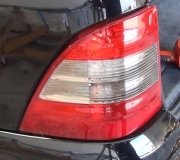The flasher is no longer the common sense, reliable, three-dollar mechanical unit. It is now a small electronic module that senses current flow. The old ones stopped flashing when a bulb was burned out because there wasn't enough current flow to warm up the internal heater wire. The insane engineers have decided we need an electronic system to monitor current flow. When there isn't enough, they flash really fast. That is probably what you're hearing.
The easiest fix is to add the same number of filament-type bulbs as you removed with the box. Put them in a small enclosure and hide it under the back of the truck. You could do the same thing with resistors but they would have to be pretty beefy to handle the current. A standard brake light bulb draws roughly one amp, so using Ohm's Law, that means its resistance would have to be around 12 ohms. If two signal bulbs were used on each side on the rear, they would be in parallel, so you'd need a 6 ohm resistor. Power equals volts times amps, so you'd have either 1 amp times 12 volts equals a 12 watt resistor for replacing a single bulb, or 2 amps times 12 volts equals a 24 watt resistor for a double bulb system. You could get by with lower wattage resistors than I calculated because the current turns off half the time, but you still would not get by with the little common half watt resistors you can find at Radio Shack. Those WOULD work for a few minutes to verify I calculated the right values but they would get hot real fast and eventually burn out.
With a bulb or two hidden away, you would know for sure you had the right resistance value and you know it will handle the current because that's what they were designed for. Just remember that bulbs get hot from the current flow and resistors do too. A little half watt resistor and a 20 watt one will develop the same amount of heat so don't mount them inside the lens as it could cause it to melt. The 20 watt resistor is simply bigger physically so it can dissipate that heat better.
I never experimented with led lights yet or these new flasher units, but I'm guessing the 12 or 6 ohms I calculated is not real critical. You might start off with a 20 ohm, for example. That would draw less current because it has more resistance to that current flow, therefore it would dissipate less power and could be a less expensive lower power resistor. Once you have one side flashing properly, do the same thing on the other side with the same value resistor or number of bulbs.
Wednesday, December 21st, 2011 AT 8:37 PM


